Download Pdf [2,77 MB] - MTU Aero Engines
Download Pdf [2,77 MB] - MTU Aero Engines
Download Pdf [2,77 MB] - MTU Aero Engines
Create successful ePaper yourself
Turn your PDF publications into a flip-book with our unique Google optimized e-Paper software.
Tube segment with machined K3 spray coating on the<br />
inner diameter.<br />
The K3 process also scores high when it<br />
comes to coating thickness. There is virtually<br />
no limit, and even several centimeters are<br />
achievable, enthuse the <strong>MTU</strong> engineers.<br />
Another advantage of the new process<br />
relates to the diameter of the spray jet,<br />
which can be focused down to about five millimeters,<br />
enabling it to precisely follow surface<br />
contours and selectively apply coatings,<br />
sometimes even without the need for masking.<br />
For comparison, Hertter points out that<br />
with flame spraying processes the diameter<br />
of the spraying cone is much larger. In other<br />
words, the coating efficiency of the new K3<br />
process is much higher, and according to the<br />
<strong>MTU</strong> expert can reach 90 percent, whereas<br />
the best result with flame spraying is 40 percent.<br />
Despite its many advantages, kinetic cold<br />
gas spraying is not a universal solution. “Each<br />
thermal spray process has applications for<br />
which it is particularly suited, and K3 cannot<br />
be a substitute for all of them,” according to<br />
Kopperger. One of the requirements of the<br />
new process is that the coating material<br />
must be ductile, which rules out its use as a<br />
means of depositing ceramic coatings. And if<br />
certain areas of the component have to be<br />
protected from the particle spray, sophisticated<br />
steel maskings have to be used,<br />
whereas simple adhesive tape is sufficient<br />
for other thermal spray processes. Kopperger<br />
therefore sees K3 mainly as a solution for<br />
applications “that wouldn’t have been possible<br />
before,” such as depositing functional<br />
structures on precisely defined areas of a<br />
component.<br />
Hertter reports that the team is currently<br />
testing the process as a means of restoring<br />
damaged areas of steel, nickel, titanium, and<br />
magnesium engine casing components. The<br />
new process even permits repairs that used<br />
to make no sense from an economic point of<br />
view. Worn-down flanges of engine casing<br />
components, for example, would be carefully<br />
cut out, repaired and then welded back in<br />
place. But in most cases the high heat input<br />
during welding would cause the casing to<br />
distort to such an extent that the repaired<br />
component would have to be scrapped anyway.<br />
“We are working on a solution that involves<br />
spraying material onto the casing<br />
Aluminum tube with K3 spray coating and spray gun.<br />
using the new process and then reworking<br />
the new flange,” says Hertter. If this is successful,<br />
the developers intend to use the<br />
same approach to restore sealing fins or to<br />
eliminate machining defects by applying a<br />
new layer of material.<br />
According to Hertter <strong>MTU</strong> has been working<br />
intensively on the K3 project since 2008. In<br />
the first phase, the process was used exclusively<br />
on non-safety-critical components.<br />
Now the aim is to perfect the coating technique<br />
to the point where it can be safely<br />
used to repair or coat rotating parts. “We plan<br />
to introduce K3 as a standard process for<br />
repairs to blades of the Tornado’s RB199<br />
engine by around 2012,” reports Kopperger.<br />
It will not be introduced in commercial maintenance<br />
until some time later, the expert goes<br />
on to say, because in this area the company<br />
needs to obtain the approval of its consortium<br />
partners, whereas in the military sector it can<br />
undertake work under its sole responsibility.<br />
Naturally, the competitors are not sitting idle<br />
and are pursuing similar developments, says<br />
Kopperger, who has been keeping a close eye<br />
on the market. “But whatever happens, we<br />
can rightly claim to have pioneered the use<br />
of the K3 process in the engine industry.”<br />
For additional information, contact<br />
Dr. Manuel Hertter<br />
+49 89 1489-3264<br />
For further information on<br />
this article, go to<br />
www.mtu.de/210K3<br />
Aluminum tube with K3 coating in the finish-machined condition.<br />
28 Technology + Science<br />
29


![Download Pdf [2,77 MB] - MTU Aero Engines](https://img.yumpu.com/11154943/15/500x640/download-pdf-277-mb-mtu-aero-engines.jpg)


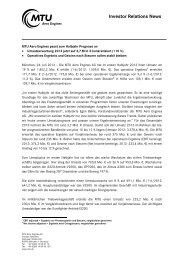
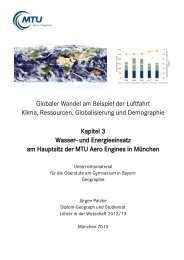
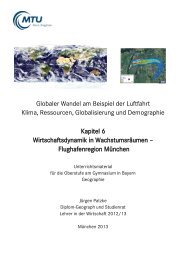
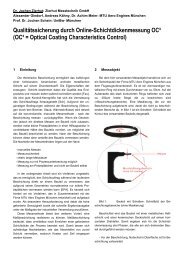
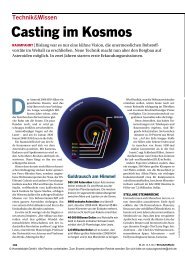


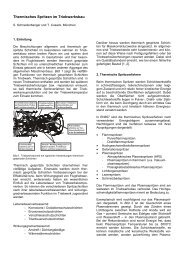
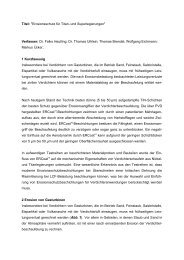


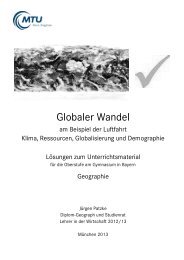
![Download PDF [5,37 MB] - MTU Aero Engines](https://img.yumpu.com/21945461/1/190x125/download-pdf-537-mb-mtu-aero-engines.jpg?quality=85)